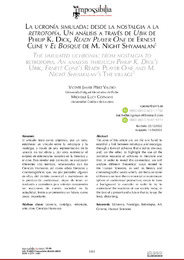Por favor, use este identificador para citar o enlazar este ítem:
https://hdl.handle.net/11000/33784Registro completo de metadatos
| Campo DC | Valor | Lengua/Idioma |
|---|---|---|
| dc.contributor.author | Pérez Valero, Vicente Javier | - |
| dc.contributor.author | Copmans, Michelle | - |
| dc.contributor.other | Departamentos de la UMH::Arte | es_ES |
| dc.date.accessioned | 2024-11-05T12:12:52Z | - |
| dc.date.available | 2024-11-05T12:12:52Z | - |
| dc.date.created | 2023-05-30 | - |
| dc.identifier.citation | Impossibilia: revista internacional de estudios literarios, Nº 25, 2023, págs. 101-114 | es_ES |
| dc.identifier.issn | 2174-2464 | - |
| dc.identifier.uri | https://hdl.handle.net/11000/33784 | - |
| dc.description.abstract | El artículo tiene como objetivos, por un lado, establecer un vínculo entre la retrotopía y la nostalgia, a través de una representación de la ucronía no tan obvia y, por otro, evidenciar el empleo de este recurso narrativo en la literatura y el cine. Para revelar esta conexión, se analizarán diferentes vías teóricas, relacionadas con las Ciencias Humanas, así como obras literarias y cinematográficas que, no por proceder, algunas de ellas, del ámbito comercial o mainstream de la producción audiovisual, dejan de tener un trasfondo a considerar para intentar comprender las reacciones de nuestra sociedad en la actualidad, frente a un presente y un futuro, como poco, inquietante. | es_ES |
| dc.description.abstract | The aims of this article are, on the one hand, to establish a link between retrotopia and nostalgia, through a form of uchronia that is not so obvious, and, on the other, to highlight the use of the narrative resource of uchronia in literature and film. In order to reveal this connection, we will analyse different theoretical ways related to the Human Sciences, as well as literary and cinematographic works which, not because some of them come from the commercial or mainstream sphere of audiovisual production, cease to have a background to consider in order to try to understand the reactions of our society today, in the face of a present and a future that is, to say the least, disturbing. | es_ES |
| dc.format | application/pdf | es_ES |
| dc.format.extent | 14 | es_ES |
| dc.language.iso | spa | es_ES |
| dc.publisher | Universidad de Granada | es_ES |
| dc.rights | info:eu-repo/semantics/openAccess | es_ES |
| dc.rights | Attribution-NonCommercial-NoDerivatives 4.0 Internacional | * |
| dc.rights.uri | http://creativecommons.org/licenses/by-nc-nd/4.0/ | * |
| dc.subject | Ucronía | es_ES |
| dc.subject | Nostalgia | es_ES |
| dc.subject | Retrotopía | es_ES |
| dc.subject | Cine | es_ES |
| dc.subject | Arte | es_ES |
| dc.subject.other | CDU::7 - Bellas artes | es_ES |
| dc.title | La ucronía simulada: desde la nostalgia a la retrotopía. Un análisis a través de Ubik de Philip K. Dick, Ready Player One de Ernest Cline y El Bosque de M. Night Shyamalan | es_ES |
| dc.title.alternative | The simulated uchronia: from nostalgia to retrotopia. An analysis throught Philip K. Dick's Ubik, Ernest Cline's Ready Player One and M. Night Shyamalan's The Village | es_ES |
| dc.type | info:eu-repo/semantics/article | es_ES |
| dc.relation.publisherversion | https://doi.org/10.30827/impossibilia.252023.26903 | es_ES |

Ver/Abrir:
La ucronía simulada. Desde la nostalgia a la retrotopía.pdf
438,14 kB
Adobe PDF
Compartir:
 La licencia se describe como: Atribución-NonComercial-NoDerivada 4.0 Internacional.
La licencia se describe como: Atribución-NonComercial-NoDerivada 4.0 Internacional.
.png)